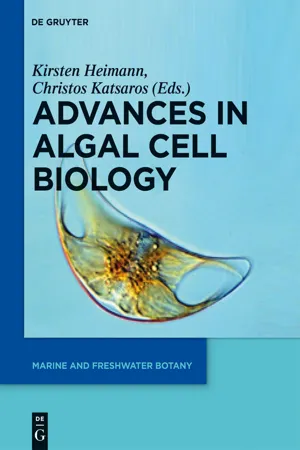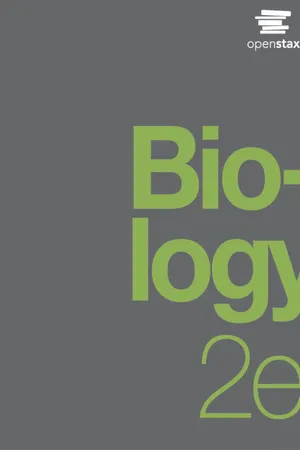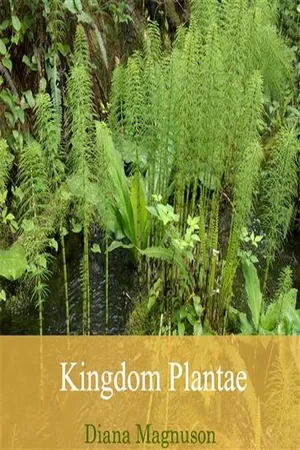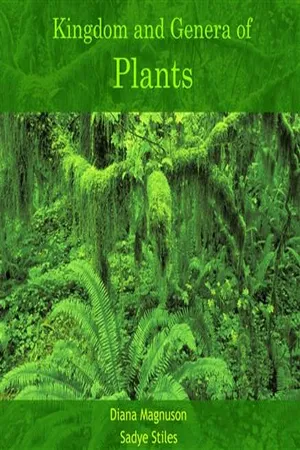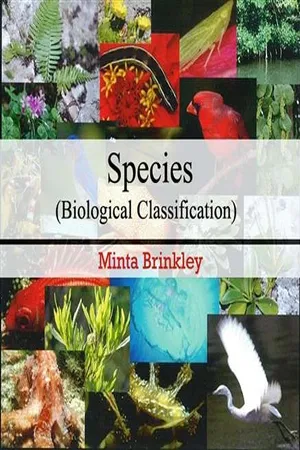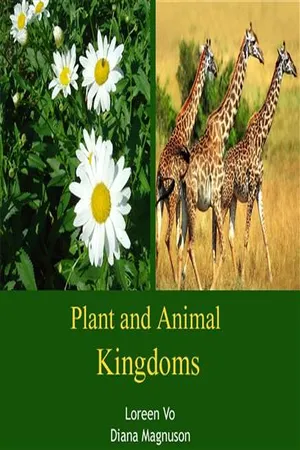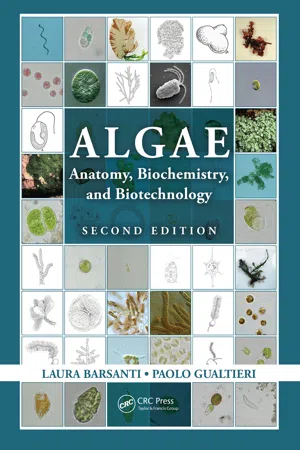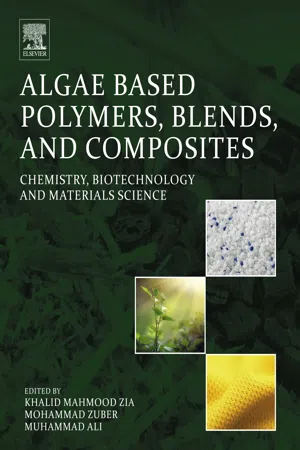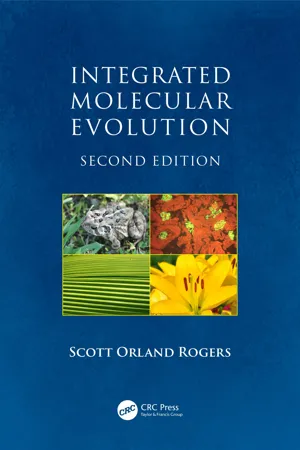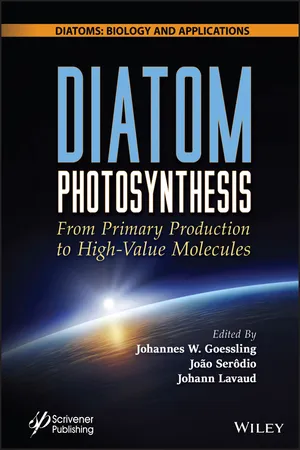Biological Sciences
Archaeplastida
Archaeplastida is a supergroup of eukaryotes that includes red algae, green algae, and land plants. It is characterized by the presence of chloroplasts derived from a primary endosymbiotic event involving a cyanobacterial ancestor. This group is significant in the evolutionary history of photosynthetic organisms and has had a major impact on the Earth's ecosystems.
Written by Perlego with AI-assistance
11 Key excerpts on "Archaeplastida"
- eBook - PDF
- Kirsten Heimann, Christos Katsaros, Kirsten Heimann, Christos Katsaros(Authors)
- 2012(Publication Date)
- De Gruyter(Publisher)
Adl et al. coined the term ‘ Archaeplastida’ for the group including these three lineages, noting that its ‘plastid’ can be “secondarily lost or reduced in some” members (Adl et al. 2005). Thus, in their system, Archaeplastida is not necessarily restricted to phototrophic eukary-otes. As we shall see, phylogenomic studies using multi-gene datasets differ in their support – or lack of support – for Archaeplastida monophyly depending on the dataset used in the analysis (Rodríguez-Ezpeleta et al. 2005; Burki et al. 2008; Hampl et al. 2009; Parfrey et al. 2010). Primary plastid-bearing eukaryotes share many common cellular and genomic fea-tures, but each of the three lineages also possess their own distinctive suite of charac-teristics. For example, green plants use the photosynthetic pigment chlorophyll b as an antenna pigment, in contrast to the phycobilins found in cyanobacteria, glaucophytes and red algae (Kim and Archibald 2009). Red algae possess the above-mentioned non-cyanobacterial RuBisCO enzyme, and glaucophyte plastids are unique in their reten-tion of a peptidoglycan wall, as found in extant cyanobacteria but not in other algae (Löffelhardt and Bohnert 2004). How these distinctive characters should be interpreted in light of plastid evolution is a topic of ongoing debate. How many times did primary plastids arise? Various hypotheses for the origin of primary plastids are summarized in Figure 2.1. Four basic hypotheses are presented in the context of a hypothetical eukaryotic tree with primary plastid-bearing eukaryotes occupying different positions. As we shall see, the position of the root on these trees is important for interpreting the distribution of plastids. Figure 2.1A depicts the most popular and currently prevailing scenario, i.e., that all primary plastids originated only once from the single primary endosymbiosis, in the common ancestor of a monophyletic clade of primary plastid-bearing eukaryotes. - eBook - PDF
- Mary Ann Clark, Jung Choi, Matthew Douglas(Authors)
- 2018(Publication Date)
- Openstax(Publisher)
640 Chapter 23 | Protists This OpenStax book is available for free at http://cnx.org/content/col24361/1.8 Archaeplastida Molecular evidence supports the hypothesis that all Archaeplastida are descendents of an endosymbiotic relationship between a heterotrophic protist and a cyanobacterium. The protist members of the group include the red algae and green algae. It was from a common ancestor of these protists that the land plants evolved, since their closest relatives are found in this group. The red and green algae include unicellular, multicellular, and colonial forms. A variety of algal life cycles exists, but the most complex is alternation of generations, in which both haploid and diploid stages are multicellular. A diploid sporophyte contains cells that undergo meiosis to produce haploid spores. The spores germinate and grow into a haploid gametophyte, which then makes gametes by mitosis. The gametes fuse to form a zygote that grows into a diploid sporophyte. Alternation of generations is seen in some species of Archaeplastid algae, as well as some species of Stramenopiles (Figure 23.10). In some species, the gametophyte and sporophyte look quite different, while in others they are nearly indistinguishable. Glaucophytes Glaucophytes are a small group of Archaeplastida interesting because their chloroplasts retain remnants of the peptidoglycan cell wall of the ancestral cyanobacterial endosymbiont (Figure 23.10). Figure 23.10 Glaucocystis. (credit: By ja:User:NEON / commons:User:NEON_ja - Own work, CC BY-SA 2.5, https://commons.wikimedia.org/w/index.php?curid=1706641 (http://openstax.org/l/Glaucocystis) ) Red Algae Red algae, or rhodophytes lack flagella, and are primarily multicellular, although they range in size from microscopic, unicellular protists to large, multicellular forms grouped into the informal seaweed category. Red algae have a second cell wall outside an inner cellulose cell wall. - No longer available |Learn more
- (Author)
- 2014(Publication Date)
- White Word Publications(Publisher)
In Linnaeus' system, these became the Kingdoms Vegetabilia (later Metaphyta or Plantae) and Animalia (also called Metazoa). Since then, it has become clear that the Plantae as originally defined included several unrelated groups, and the fungi and several groups of algae were removed to new kingdoms. However, these are still often considered plants in many contexts, both technical and popular. ________________________ WORLD TECHNOLOGIES ________________________ Current definitions of Plantae When the name Plantae or plant is applied to a specific taxon, it is usually referring to one of three concepts. From least to most inclusive, these three groupings are: Name(s) Scope Description Land plants, also known as Embryophyta or Metaphyta. Plantae sensu strictissimo This group includes the liverworts, hornworts, mosses, and vascular plants, as well as fossil plants similar to these surviving groups. Green plants - also known as Viridiplantae , Viridiphyta or Chlorobionta Plantae sensu stricto Includes the land plants plus Charophyta (i.e. stoneworts), and Chlorophyta (i.e., other green algae such as sea lettuce). Viridiplantae encompass a group of organisms that possess chlorophyll a and b , have plastids that are bound by only two membranes, are capable of storing starch, and ha ve cellulose in their cell walls. Archaeplastida, Plastida or Primoplantae Plantae sensu lato Comprises the green plants above plus Rhodophyta (red algae) and Glaucophyta (glaucophyte algae). This clade includes the organisms that eons ago acquired thei r chloroplasts directly by engulfing cyanobacteria. Outside of formal scientific contexts, the term plant implies an association with certain traits, such as multicellularity, cellulose, and photosynthesis. Many of the classification controversies involve organisms that are rarely encountered and are of minimal apparent economic significance, but are crucial in developing an understanding of the evolution of modern flora. - No longer available |Learn more
- (Author)
- 2014(Publication Date)
- Academic Studio(Publisher)
In Linnaeus' system, these became the Kingdoms Vegetabilia (later Metaphyta or Plantae) and Animalia (also called Metazoa). Since then, it has become clear that the Plantae as originally defined included several unrelated groups, and the fungi and several groups of algae were removed to new kingdoms. However, these are still often considered plants in many contexts, both technical and popular. ________________________ WORLD TECHNOLOGIES ________________________ Current definitions of Plantae When the name Plantae or plant is applied to a specific taxon, it is usually referring to one of three concepts. From least to most inclusive, these three groupings are: Name(s) Scope Description Land plants, also known as Embryophyta or Metaphyta. Plantae sensu strictissimo This group includes the liverworts, hornworts, mosses, and vascular plants, as well as fossil plants similar to these surviving groups. Green plants - also known as Viridiplantae , Viridiphyta or Chlorobionta Plantae sensu stricto Includes the land plants plus Charophyta (i.e. stoneworts), and Chlorophyta (i.e., other green algae such as sea lettuce). Viridiplantae encompass a group of organisms that possess chlorophyll a and b , have plastids that are bound by only two membranes, are capable of storing starch, and have cellulose in their cell walls. Archaeplastida, Plastida or Primoplantae Plantae sensu lato Comprises the green plants above plus Rhodophyta (red algae) and Glaucophyta (glaucophyte algae). This clade includes the organisms th at eons ago acquired their chloroplasts directly by engulfing cyanobacteria. Outside of formal scientific contexts, the term plant implies an association with certain traits, such as multicellularity, cellulose, and photosynthesis. Many of the classification controversies involve organisms that are rarely encountered and are of minimal apparent economic significance, but are crucial in developing an understanding of the evolution of modern flora. - No longer available |Learn more
- (Author)
- 2014(Publication Date)
- White Word Publications(Publisher)
In Linnaeus' system, these became the Kingdoms Vegetabilia (later Metaphyta or Plantae) and Animalia (also called Metazoa). Since then, it has become clear that the Plantae as originally defined included several unrelated groups, and the fungi and several groups of algae were removed to new kingdoms. However, these are still often considered plants in many contexts, both technical and popular. ________________________ WORLD TECHNOLOGIES ________________________ Current definitions of Plantae When the name Plantae or plant is applied to a specific taxon, it is usually referring to one of three concepts. From least to most inclusive, these three groupings are: Name(s) Scope Description Land plants, also known as Embryophyta or Metaphyta. Plantae sensu strictissimo This group includes the liverworts, hornworts, mosses, and vascular plants, as well as fossil plants similar to these surviving grou ps. Green plants - also known as Viridiplantae , Viridiphyta or Chlorobionta Plantae sensu stricto Includes the land plants plus Charophyta (i.e. stoneworts), and Chlorophyta (i.e., other green algae such as sea lettuce). Viridiplantae encompass a group of organisms that possess chlorophyll a and b , have plastids that are bound by only two membranes, are capable of storing starch, and have cellulose in their cell walls. Archaeplastida, Plastida or Primoplantae Plantae sensu lato Comprises the green plants above plus Rhodophyta (red algae) and Glaucophyta (glaucophyte algae). This clade includes the organisms that eons ago acquired their chloroplasts directly by engulfing cyanobacteria. Outside of formal scientific contexts, the term plant implies an association with certain traits, such as multicellularity, cellulose, and photosynthesis. Many of the classification controversies involve organisms that are rarely encountered and are of minimal apparent economic significance, but are crucial in developing an understanding of the evolution of modern flora. - No longer available |Learn more
- (Author)
- 2014(Publication Date)
- Academic Studio(Publisher)
In Linnaeus' system, these became the Kingdoms Vegetabilia (later Metaphyta or Plantae) and Animalia (also called Metazoa). Since then, it has become clear that the Plantae as originally defined included several unrelated groups, and the fungi and several groups of algae were removed to new kingdoms. However, these are still often considered plants in many contexts, both technical and popular. ________________________ WORLD TECHNOLOGIES ________________________ Current definitions of Plantae When the name Plantae or plant is applied to a specific taxon, it is usually referring to one of three concepts. From least to most inclusive, these three groupings are: Name(s) Scope Description Land plants, also known as Embryophyta or Metaphyta. Plantae sensu strictissimo This group includes the liverworts, hornworts, mosses , and vascular plants, as well as fossil plants similar to these surviving groups. Green plants - also known as Viridiplantae , Viridiphyta or Chlorobionta Plantae sensu stricto Includes the land plants plus Charophyta (i.e. stoneworts), and Chlorophyta (i .e., other green algae such as sea lettuce). Viridiplantae encompass a group of organisms that possess chlorophyll a and b , have plastids that are bound by only two membranes, are capable of storing starch, and have cellulose in their cell walls. Archaeplastida, Plastida or Primoplantae Plantae sensu lato Comprises the green plants above plus Rhodophyta (red algae) and Glaucophyta (glaucophyte algae). This clade includes the organisms that eons ago acquired their chloroplasts directly by engulfing cyanobacteria. Outside of formal scientific contexts, the term plant implies an association with certain traits, such as multicellularity, cellulose, and photosynthesis. Many of the classification controversies involve organisms that are rarely encountered and are of minimal apparent economic significance, but are crucial in developing an understanding of the evolution of modern flora. - eBook - PDF
Algae
Anatomy, Biochemistry, and Biotechnology, Second Edition
- Laura Barsanti, Paolo Gualtieri(Authors)
- 2014(Publication Date)
- CRC Press(Publisher)
Chlorophyta (green algae and plants) constitute the second lineage of primary plastids. The simple two-membrane system surrounding the plastid, the congruence of phylogenies based on nuclear and organellar genes, and the antiquity of the green algae in the fossil record all indicate that the green algal plastid is of primary origin. In these chloroplasts, chlorophyll b was synthesized as a secondary pigment, phycobiliproteins were lost, and starch was stored. Another hypothesis suggested that the photosynthetic ancestor of green lineage was a prochlorophyte that possessed chlorophylls a and b and lacked phycobiliproteins. The green lineage played a major role in oceanic food webs and the carbon cycle from about 2.2 billion years ago until the end-Permian extinction, approximately 250 million years ago. It was this similarity to the pigments of plants that led to the inference that the ancestors of land plants (i.e., embryophytes) would be among the green algae and is clear that phylogenetically plants are a group of green algae adapted to life on land. The plastids of Rhodophyta (red algae) constitute the third primary plastid lineage. Like the green algae, the red algae are also an ancient group in the fossil record, and some of the oldest fos-sils interpreted as being of eukaryotic origin are often referred to the red algae, although clearly these organisms were very different from any extant alga. Like those of green algae, the plastids of red algae are surrounded by two membranes. However, they are pigmented with chlorophyll a , phycobiliproteins, organized into phycobilisomes, and are distinguished by the presence of phyco-erithrin. Phycobilisomes are relatively large extrinsic antennas, water-soluble, and attached to the surface of the thylakoid membrane. Thylakoids with phycobilisomes do not form stacks like those in other plastids and consequently the plastids of red algae (and glaucophytes) bear an obvious ultra-structural resemblance to cyanobacteria. - eBook - ePub
Organelles, Genomes and Eukaryote Phylogeny
An Evolutionary Synthesis in the Age of Genomics
- Robert P Hirt, David S. Horner(Authors)
- 2004(Publication Date)
- CRC Press(Publisher)
Subsequently, other genes have been analyzed individually and in combination, and altogether the case for multiple independent plastid origins has evaporated. Several nuclear genes have shown a weak relationship between red and green algae, including enolase; actin (in some analyses); α-tubulin; hsp70; hsp90; α and β subunits of vacuolar ATPase; and a combined analysis of α- and β-tubulins, EF-1α and actin (Archibald et al., 2001; Baldauf et al., 2000; Keeling, 2001; Keeling et al., 1999; Keeling and Palmer, 2001; Moreira et al., 2000; Stibitz et al., 2000). Moreover, the phylogeny of translation elongation factor 2 (EF-2) was shown to support the monophyly of red and green algae with very high statistical support, as was a combined analysis of 13 nuclear-encoded cytosolic genes (Moreira et al., 2000). Conversely, a reanalysis of the RPB1 gene failed to reject the possibility of a monophyletic red and green algae (Moreira et al., 2000). Recent analyses of RPB1 have also shown the red and green algae to branch together, albeit weakly (D.Longet, JMA, PJK and J.Pawlowski, unpublished data). For glaucocystophytes, there is little molecular data from nuclear genes, but some genes show them branching with the red or green algae, or both (e.g., Stibitz et al., 2000), and two multigene analyses also concluded that the red and green algae were closely related to the glaucocystophytes (Baldauf et al., 2000; Moreira et al., 2000). Altogether, the consistent picture coming from plastid genes, mitochondrial genes and nuclear genes is the same: red, green and glaucocystophyte algae share a common ancestor, and the origin of primary plastids can reasonably be inferred to trace back to a single endosymbiotic event.3.4 Three Lineages
At present, primary plastids are found in only three lineages of eukaryotes: the glaucocystophytes, the red algae and the green algae (and their land plant relatives). Land plants and green algae are a pervasive and dominant group of eukaryotes. Green algae are found in almost every aquatic and marine environment known and are an extremely diverse and specious group. The green algal lineage is deeply divided into two major subgroups, the chlorophytes and streptophytes, and land plants evolved from within the streptophyte clade. Green algae and land plants are characterized by the presence of chlorophylls a and b in their plastid. Red algae are also a very diverse and specious group. They are predominantly marine but are also present in freshwater environments, and some red algae inhabit relatively hostile environments such as high heat or high salinity. Certain red algae have evolved a complex form of multicellularity not unlike plants in many respects. Red algal plastids are also distinctive as they contain chlorophyll a and phycobilins, the latter being accessory pigments associated with structures called phycobilisomes that are visible by electron microscopy on the outside of the inner plastid membrane. Glaucocystophytes are a relatively small group of algae, with only three genera and a handful of species. The glaucocystophytes also contain chlorophyll a - eBook - ePub
Algae Based Polymers, Blends, and Composites
Chemistry, Biotechnology and Materials Science
- Khalid Mahmood Zia, Mohammad Zuber, Muhammad Ali(Authors)
- 2017(Publication Date)
- Elsevier(Publisher)
Chapter 4Origin of Algae and Their Plastids
Nadia Sharif1 , Neelma Munir1 , Shagufta Naz1 , Rehana Iqbal2 , and Waqar Rauf31 Lahore College for Women University, Lahore, Pakistan2 Bahauddin Zakariya University, Multan, Pakistan3 National Institute of Biology & Genetics Engineering (NIBGE), Faisalabad, PakistanAbstract
Algae are of central importance in marine and freshwater ecosystems; however, their origin has remained an enigma. Recent molecular sequence analyses show that algae are of polyphyletic origins, and that their evolution is best explained by tracing the endosymbiotic events, which resulted in the origins of their plastids. Plastid is a major double-membrane cytoplasmic semiautonomous organelles, it synthesize or store various types of organic compounds. Plastids are derived from endosymbiotic event through a complex mix of movement, loss and replacement, non-photosynthetic plastids are being found in many non-photosynthetic lineages. In other cases, photosynthetic lineages have evolved from ancestors with a plastid of different origin, so an ancestral plastid has been replaced with a new one. On the basis of origin of algae and their plastids, the four distinct groups of algae include prokaryotes—the cyanobacteria; chloroplast-containing eukaryotic algae with one membrane of chloroplast endoplasmic reticulum (ER); chloroplast-containing eukaryotic algae that are surrounded by two membranes of chloroplast ER; and chloroplast-containing eukaryotic algae that are surrounded by two membranes of the chloroplast envelope. Fatty acids, heme, amino acids, and aromatic isoprenoids are some of the significant compounds synthesized by algal plastids through photosynthetic and biochemical pathways.Keywords
Algae; Chlorophyll; Endosymbiont; Endosymbiosis; Eukaryogenesis; Phospholipid; Phycobilins; Phycobilisomes; Plastids4.1. Introduction
- eBook - ePub
- Scott Orland Rogers(Author)
- 2016(Publication Date)
- CRC Press(Publisher)
By 1.2 billion years ago, some members of one line of the Archaeplastida had undergone changes in their photosynthetic and other cellular processes, becoming unicellular chlorophytes (green algae). Initially, most were unicellular, but soon thereafter several multicellular forms appeared. Some were essentially collections of identical or very similar cells, while in others more than one cell type developed (Figure 17.2). As the organisms evolved, the cell types became more differentiated from one another, taking on different roles in the body of the organism. For example, in some of the multicellular organisms, there were cells specialized in motility and orientation of the organism to optimize the amount of photosynthesis, while other cells performed the majority of the photosynthetic processes for the organism. One branch of the Chlorophyta diverged and led to the evolution of all other groups of the Archaeplastida, including the unicellular Prasinophyta (marine and freshwater planktonic algae), and the multicellular taxa from the Charophyta (freshwater green algae) to the Spermatopsida (seed plants, such as gymnosperms and angiosperms). Some unicellular rhodophytes and chlorophytes became endosymbionts, and later organelles, of several protist groups, including Chromalveolata (Chromista, Stramenopiles, and Hacrobians) and Excavata. Some of these groups diversified to produce unicellular and multicellular forms, including the brown algae, golden algae, yellow-green algae, diatoms, dinoflagellates, and others. Thus, the innovation of photosynthesis was transferred via horizontal gene transfer of entire genomes to other kingdoms of organisms. As the evolution of these lineages continued, the male and female gametes became more specialized and had different morphologies - eBook - PDF
Diatom Photosynthesis
From Primary Production to High-Value Molecules
- Johannes Wilhelm Goessling, João Serodio, Johann Lavaud(Authors)
- 2024(Publication Date)
- Wiley-Scrivener(Publisher)
This has been stated by Strassert et al. [3.150], who conducted a molecu- lar clock study and found that Cryptista, the group containing cryptophytes, branched from the ancestors of Archaeplastida earlier than the diversification within the Archaeplastida, which means that at this time, red algal endosymbionts were not available to the ancestor of cryptophytes [3.150]. Strassert et al. [3.150] date the origin of complex plastids of red algal 90 Diatom Photosynthesis origin to a time window between 650 and 1079 million years ago, thus favouring a rhodo- plex hypothesis-like scenario. In summary, accumulating evidence suggests that the serial endosymbiotic hypothesis is the most likely scenario for the evolution of algae with rhodophyte-derived complex plas- tids. Generally, the evaluation of the concurrent hypothesis is strongly influenced by the weighting of the probabilities of plastid gains versus plastid losses. Cavalier-Smith’s chro- malveolate hypothesis [3.25] is driven by the underlying assumption that a plastid gain is complicated, and therefore applies a cost assignment which implicitly accepts that plastid losses must be easier than plastid gains. Cavalier-Smith also pointed out that early in plastid evolution, when the host would not be fully dependent on the plastid, plastid losses would be easier than later in evolution [3.28]. Moreover, a plastid that would have been lost early in evolution, would also be less likely to leave traces in the nuclear genome. But how eas- ily can a plastid (or other organelle) disappear to a state in which it is undetectable? This question is not easy to answer, because when looking at the known eukaryotic biodiversity, we can only see the plastids that are there, but not those that are not. Therefore, in order to clarify the exact evolutionary paths of plastids in extant organisms, actual sampling of algal lineages in a time-series over evolutionary timescales would be the scientifically appro- priate approach.
Index pages curate the most relevant extracts from our library of academic textbooks. They’ve been created using an in-house natural language model (NLM), each adding context and meaning to key research topics.
